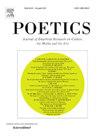IF 2
2区 社会学
0 LITERATURE
引用次数: 0
摘要
对作家政治取向的分析通常侧重于单个作家的作品和创作轨迹。受布尔迪厄的场域理论和萨皮罗关于法国文学场域的著作的启发,本文论证了挪威作家在二战期间的立场取向如何与他们在另外两组结构中的位置相关:20世纪30年代和40年代挪威文学实践场域的结构,以及他们在文化、经济和社会资本等级制度中的位置。根据308位作家的数据,我们提出了以下问题:作家和知识分子是如何应对民主倒退、文化自主权丧失和专制主义抬头的?本文章由计算机程序翻译,如有差异,请以英文原文为准。
Literary practices, capital structures and political position-taking: The Norwegian writers during World War II
Analyses of writers’ political orientations have typically focused on individual authors’ works and trajectories. Inspired by Bourdieu's field theory and by Sapiro's works on the French literary field, this article demonstrates how the Norwegian writers’ position-takings during WW II were related to their locations in two other sets of structures: the structures in the Norwegian field of literary practices in the 1930s and '40s, and their locations in cultural, economic and social capital hierarchies. Based on data on 308 writers we ask: How did the writers and intellectuals respond to democratic backsliding, loss of cultural autonomy and authoritarianism on the rise?
Three main literary oppositions were uncovered by way of MCA: Non-Fiction vs. Fiction, Traditional vs Modern literature and Popular vs. Other literature. These oppositions were structured along hierarchies of personal and inherited cultural capital, and of economic capital. The association between literary and political orientations was clear. Urban, modern-oriented writers with upper-class backgrounds had higher probabilities of partaking in resistance, while more marginal, tradition-oriented writers with a lower-class origin had higher probabilities of supporting the occupation; during WWII, the literary elite thus faced both an external shock and a challenge “from below”.
Out of eight literary clusters, five were political: Academics, Modernists, Proletarians, National Romanticists and Vitalists. Nazi-sympathizing or collaborating writers were overrepresented in latter two. But a Class Specific MCA revealed internal divisions among the Nazi-sympathizing or collaborating writers that did not mirror those found in the global space; distinct hierarchies were at work. When analyzing how a given constellation of factors might produce different outcomes across a population, the integration of MCA and CSA therefore offers a promising approach.
求助全文
通过发布文献求助,成功后即可免费获取论文全文。
去求助
来源期刊

Poetics
Multiple-
CiteScore
4.00
自引率
16.00%
发文量
77
期刊介绍:
Poetics is an interdisciplinary journal of theoretical and empirical research on culture, the media and the arts. Particularly welcome are papers that make an original contribution to the major disciplines - sociology, psychology, media and communication studies, and economics - within which promising lines of research on culture, media and the arts have been developed.
 求助内容:
求助内容: 应助结果提醒方式:
应助结果提醒方式:


